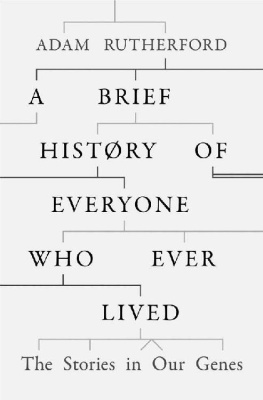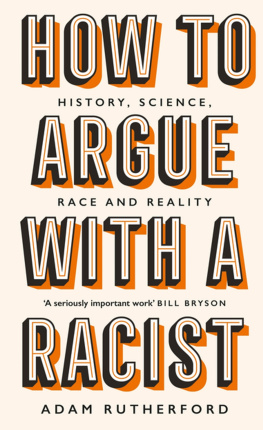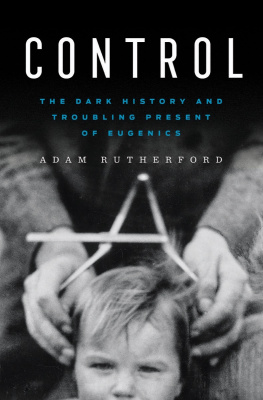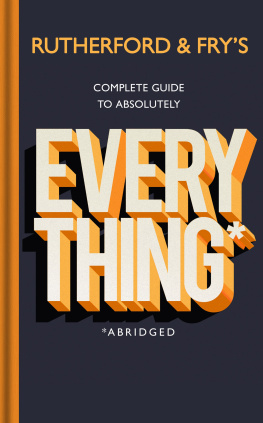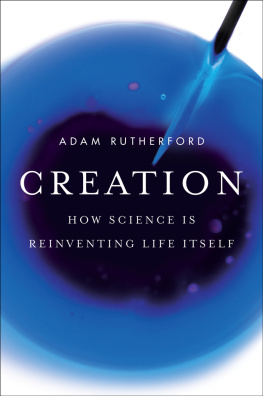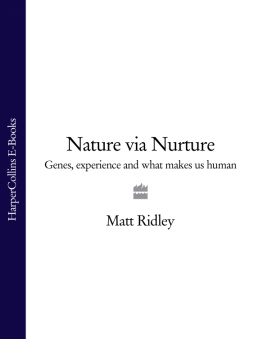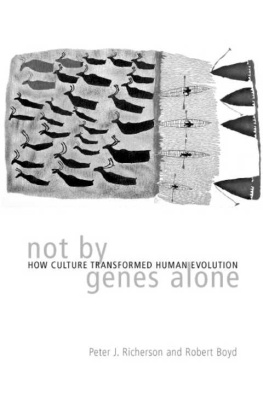Adam Rutherford - How to Argue With a Racist: What Our Genes Do (and Dont) Say About Human Difference
Here you can read online Adam Rutherford - How to Argue With a Racist: What Our Genes Do (and Dont) Say About Human Difference full text of the book (entire story) in english for free. Download pdf and epub, get meaning, cover and reviews about this ebook. year: 2020, publisher: The Experiment, genre: Romance novel. Description of the work, (preface) as well as reviews are available. Best literature library LitArk.com created for fans of good reading and offers a wide selection of genres:
Romance novel
Science fiction
Adventure
Detective
Science
History
Home and family
Prose
Art
Politics
Computer
Non-fiction
Religion
Business
Children
Humor
Choose a favorite category and find really read worthwhile books. Enjoy immersion in the world of imagination, feel the emotions of the characters or learn something new for yourself, make an fascinating discovery.

- Book:How to Argue With a Racist: What Our Genes Do (and Dont) Say About Human Difference
- Author:
- Publisher:The Experiment
- Genre:
- Year:2020
- Rating:4 / 5
- Favourites:Add to favourites
- Your mark:
- 80
- 1
- 2
- 3
- 4
- 5
How to Argue With a Racist: What Our Genes Do (and Dont) Say About Human Difference: summary, description and annotation
We offer to read an annotation, description, summary or preface (depends on what the author of the book "How to Argue With a Racist: What Our Genes Do (and Dont) Say About Human Difference" wrote himself). If you haven't found the necessary information about the book — write in the comments, we will try to find it.
How to Argue With a Racist: What Our Genes Do (and Dont) Say About Human Difference — read online for free the complete book (whole text) full work
Below is the text of the book, divided by pages. System saving the place of the last page read, allows you to conveniently read the book "How to Argue With a Racist: What Our Genes Do (and Dont) Say About Human Difference" online for free, without having to search again every time where you left off. Put a bookmark, and you can go to the page where you finished reading at any time.
Font size:
Interval:
Bookmark:


For Ananda, Ben, Jake, Nathaniel, and all
of my more distant sisters and brothers
The world is a fine place and worth the fighting for.
Ernest Hemingway,
For Whom the Bell Tolls
PART ONE
Skin in the Game
PART TWO
Your Ancestors Are My Ancestors
PART THREE
Black Power
PART FOUR
White Matter
This is a deliberately concise book, and I have selected only arguments and cases that are illustrative. I will be using terminology that is not without historical baggage, some of which is considered deeply offensive. I will be using words such as Black and East Asian while simultaneously acknowledging that they are poor scientific designations for the immense diversity within these billions of people. It is an irony that we roughly know what these descriptors mean colloquially while they are potentially incoherent in terms of scientific taxonomy. The semantics of this book and the broader public discourse are important, and one influences the other. The decision to capitalize Black, White, and any other color named in this book, when it stands for a group of people or a race as its culturally described, is more than a mere typographical choice; its a reflection of shifting attitudes regarding the way capitalizationor lack thereofcan either reinforce or undermine a sense of equal respect for all races. And although much of the book discusses the validity of the term race, I will be using it, primarily because it is a term that people recognize and use, regardless of its scientific validity. Population, ancestry, and lineage are all terms that are more useful as discussions of human evolution and diversity become more technical. This book is largely focused on racism derived from Western and European cultures, partly because these are my cultures, but also because the concepts of race that we are broadly globally wedded to emerged in Europe and were enshrined in culture alongside European expansion, the emergence of science as we recognize it today, and the values of the Enlightenment.
This book is a weapon. It is written to equip you with the scientific tools necessary to tackle questions on race, genes, and ancestry. It is a tool kit to help separate fact from myth in understanding how we are similar and how we are different.
Our story began in Africa. The earliest known members of our speciesHomo sapiensevolved in what is now Morocco around three hundred thousand years ago, though most early remains are from the east of Africa. We are starting to think that in the beginning, we came from a pan-African species, a mixture of diverse populations from around that mighty continent. We know that some early humans migrated into Asia and Europe within the last quarter of a million years, but their dominion outside of Africa was temporary, and they probably leave no descendants today. Around seventy thousand years ago another group of people drifted away from Africa, and the process of setting down new roots all over this planet began. Much of our global success is a result of local adaptations, fine-tuned by evolution to best survive environments on an ecologically diverse planet. Our quintessential nature as wanderers, hunters, farmers, and social creatures means that, over the last few thousand years, Earth has become smaller, and peoples from around the world have met, traded, mated, fought, conquered, and a whole lot more. In these interactions, we engage with people who are different from each other. These differences are rooted in biology, in DNA, and also in our behavior as social animalsin our dress, our speech, our religions, and our interests. In the pursuit of power and wealth, the fetishization of these differences has been the source of the cruelest acts in our short history.
The political climate has changed in the past few years. Around the world, nationalism is on the rise, and the presence of race in the public arena is more prominent than it has been in some time. As I write these words, cities around America are electrified by popular uprisings. Hundreds of thousands have marched, protested, and rioted (though most are impassioned but peaceful demonstrations)this time, prompted by the killing of George Floyd by a police officer in Minneapolis. This is a race conflictas it was in 2016 in Charlotte, North Carolina, after police killed an unarmed Black man named Keith Lamont Scott. Or as occurred in Ferguson, Missouri, in 2014, after unarmed teenager Michael Brown was killed by police, just as had happened to Freddie Gray in Baltimore in 2015 and Timothy Thomas in Cincinnati in 2001. Anti-racist protests sprung up all around the US in 1992, after the brutal assault of Rodney King by four Los Angeles police officersand in Miami in 1980, after four cops beat Arthur McDuffie to death for running a red light. For all these incidents, the police were either acquitted or not criminally charged. At present, the fate of the four officers involved in the killing of George Floyd remains to be seen.
These are race riotsas they arose all around the country in 1968, following the murder of Martin Luther King, Jr.
In one sense, nothing has changed. The US has never resolved its racist history, and the daily frustration of normalized prejudice endured by Black peopleand other non-White Americanstipped over into public protest and violence in May 2020, as it has many times before. Today, though, perhaps unlike the racial violence of the twentieth century, factions enabled by technology are born and nurtured on social media. Black Lives Matter began as a hashtag, following the acquittal in 2013 of the man who fatally gunned down Trayvon Martin a year and a half earlier, and it has escalated into a global movementits stated aim: to vanquish White supremacy and counter acts of violence against Black people.
Rodney Kings beating was tapedon a shaky 8-millimeter camera at a distanceand this was a foreshadowing of what would come. George Floyds death was filmed on multiple cameras: a police officers knee crushing his throat for almost nine minutes. The footage was broadcast globally within hours, and his wordsI cant breatheechoed Eric Garners exact words before his death from a police officers chokehold, on Staten Island in 2014, and thus, the slogan was revived for demonstrators around the world. The actions of protestors and police are now continually documented in a chaotic melee for all to seethe protests, the looting, the police brutality. The schisms of a country built on racist foundationson the backs of the enslavedare now more than ever exposed, like a nerve. The revolution was not televised; it was livestreamed.
The protests represent the outcome of systemic, structural racism in our societies, which is not simply born of acts of violence against Black men by the policenor from the voices of White supremacists that become mainstream. Structural racism is everydayand rooted in the everyday. It is rooted in indifference to the lived experience of the recipients of racism.
Stereotypes and myths about race are the foundations on which structural racism is built, and these have been ingrained in western culture, while laced with centuries of pseudoscience that I will dissect in these pages. We see the raw exposure of racism in both these acts of police violence and the subsequent protests and riots, but the misguided and malicious views from which these events emerge are pervasive and stubbornly entrenched. The insistence that outdated racial categories are rooted in biology is upheld not just by overt racists whose voices are amplified by modern technology but also by well-intentioned people whose experience and cultural history steer them toward views that are simply not supported by the contemporary study of human genetics: the misattribution of athletic success to ancestry rather than training, or the continued assumptions that East Asian students are inherently better at math, or the idea that Black people have some kind of natural rhythm, or the notion that Jews are good with money. We all know someone who thinks along these lines. The ideas examined in these pages form a scientific description of real human similarities and differences that will provide a foundation to contest racism that appears to be grounded in science. Here, I am focusing on four key areas where we often slip up by adhering to stereotypes and assumptions; I am outlining what we can and cannot know according to contemporary science on the subjects of skin color, ancestral purity, sports, and intelligence.
Font size:
Interval:
Bookmark:
Similar books «How to Argue With a Racist: What Our Genes Do (and Dont) Say About Human Difference»
Look at similar books to How to Argue With a Racist: What Our Genes Do (and Dont) Say About Human Difference. We have selected literature similar in name and meaning in the hope of providing readers with more options to find new, interesting, not yet read works.
Discussion, reviews of the book How to Argue With a Racist: What Our Genes Do (and Dont) Say About Human Difference and just readers' own opinions. Leave your comments, write what you think about the work, its meaning or the main characters. Specify what exactly you liked and what you didn't like, and why you think so.

